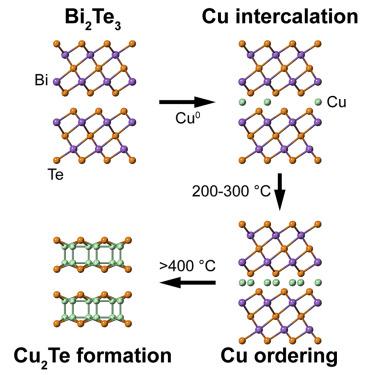Matter ( IF 17.3 ) Pub Date : 2020-08-19 , DOI: 10.1016/j.matt.2020.07.028 Pralav P. Shetty , Neha Kondekar , Akila C. Thenuwara , Matthew G. Boebinger , Salem C. Wright , Mengkun Tian , Matthew T. McDowell

|
The presence of a van der Waals gap within layered materials enables the intercalation of guest species, which can be used for tuning properties. The introduction of intercalant species may also lead to structural transformations across a range of temperatures and use conditions, but we have a limited understanding of the high-temperature evolution of intercalated layered materials. Here, we use in situ transmission electron microscopy to investigate temperature-dependent structural evolution of Bi2Te3, a layered material with well-known application as a thermoelectric, which contains intercalated Cu. As temperature is increased, the initially disordered Cu undergoes local ordering within the van der Waals gap, along with anisotropic sublimation behavior of the crystals. As the temperature is raised further, layered Cu2Te crystals nucleate and grow with a crystallographic relationship to the Bi2Te3 lattice. Notably, the presence of Cu decreases the thermal stability of the Bi2Te3 and substantially alters the transformation pathways during heating.
中文翻译:

嵌入铜的碲化铋加热过程中的原位动力学
层状材料中范德华间隙的存在使客体物种得以插入,可用于调节性能。插入物种类的引入还可能导致一定温度和使用条件范围内的结构转变,但我们对插入层状材料的高温演变了解有限。在这里,我们使用原位透射电子显微镜研究Bi 2 Te 3的温度依赖性结构演化,是一种层状材料,具有众所周知的热电应用,其中包含嵌入的Cu。随着温度升高,最初无序的Cu在范德华间隙内经历局部有序化,同时晶体也发生各向异性的升华行为。随着温度的进一步升高,层状Cu 2 Te晶体成核并以与Bi 2 Te 3晶格的晶体学关系生长。值得注意的是,Cu的存在降低了Bi 2 Te 3的热稳定性,并在加热期间实质上改变了转化途径。











































 京公网安备 11010802027423号
京公网安备 11010802027423号